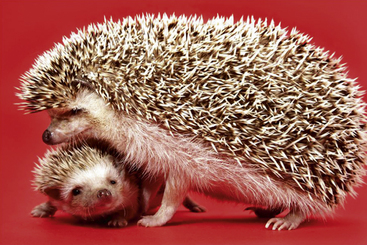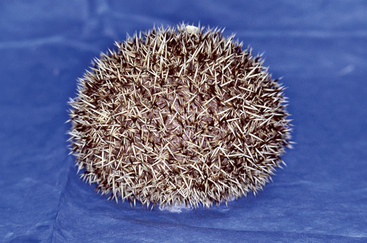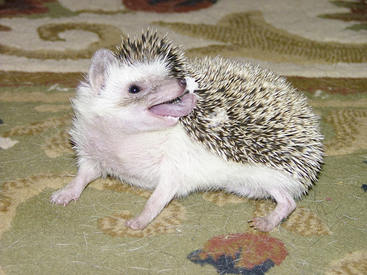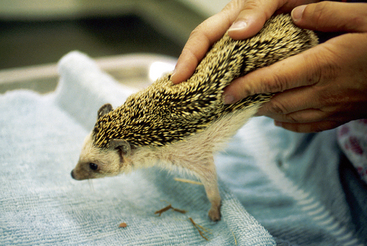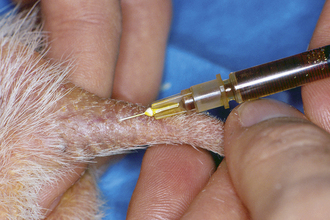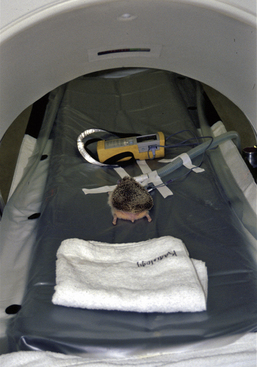Chapter 30 African Hedgehogs
Because of their small size, spiny coat, and relatively recent appearance in the pet trade, African hedgehogs can be challenging patients. Hedgehogs are illegal in some states and municipalities; in other states, a permit is required. Additionally, a permit from the U.S. Department of Agriculture (USDA) is required for persons who breed, transport, sell, exhibit, or use hedgehogs for research or teaching purposes. Even breeders who give away their progeny must be registered with the USDA, although breeders with three or fewer intact females are now excluded from this requirement. In 1991, it became illegal to import hedgehogs from Africa into the United States because of the potential transmission of foot and mouth disease to cattle.59 Hedgehog owners are advised to check with appropriate regulatory agencies, including state fish and game or wildlife departments and their regional USDA office for specific regulations.
Biology and Anatomy
Taxonomy and Natural History
Hedgehogs (Fig. 30-1) are members of the family Erinaceidae within the order Insectivora. The two most familiar hedgehog species are the central African hedgehog (Atelerix albiventris) and the European hedgehog (Erinaceus europaeus). The central African hedgehog, also known as the white-bellied, four-toed, or “African pygmy” hedgehog, is native to the savannah and steppe regions of central and eastern Africa.58 Some pet African pygmy hedgehogs are descended from hybrids of the central African and similar Algerian hedgehog (Atelerix algirus). In the pet trade, Atelerix species are generally referred to as African pygmy hedgehogs. Unless otherwise noted, the information in this chapter refers to pet African pygmy hedgehogs. Because of the ban on importation, pet hedgehogs in the United States are captive-bred; several color varieties exist and at least one show standard has emerged.
Wild African hedgehogs are found in diverse dry open habitats including grassland, scrub, and suburban yards.45 They are nocturnal and spend their daylight hours hidden in burrows or other cavities. At night, they are very active invertebrate predators, jogging several miles in search of insects, earthworms, slugs, and snails.58 Males and females are territorial and solitary except during courtship and when females raise young. Although all hedgehog species appear to be capable of entering a torpid state under cold conditions, the central African hedgehog probably does not normally experience cold temperatures in the wild, and torpor is considered to be undesirable in captives.35,58 Excessively high temperatures can also induce a torpid state.58
Anatomy and Physiology
Radiographic anatomy of the normal hedgehog is presented in Figures 30-2 and 30-3.9
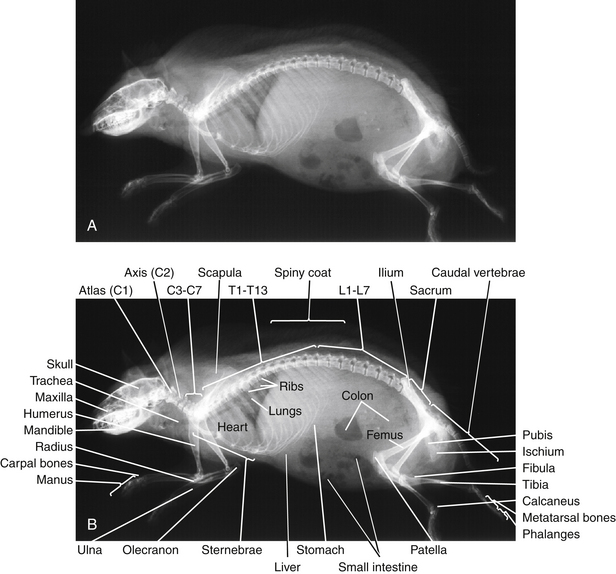
Fig. 30-2 Normal, whole body radiograph (lateral view) of a female African hedgehog; A, unlabeled; B, labeled anatomic structures.9
(Reprinted with permission of John Wiley & Sons, Inc.)
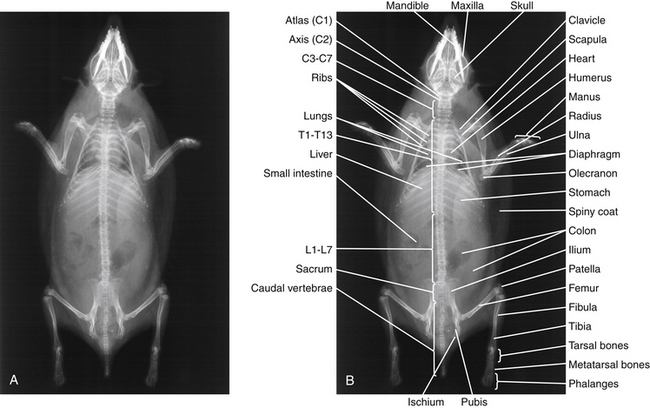
Fig. 30-3 Normal whole-body radiographs (ventrodorsal view) of a female African hedgehog. A, unlabeled. B, Labeled and showing the ischiopubic symphysis in this nonpregnant animal with no history of parturition.9
(Reprinted with permission of John Wiley & Sons, Inc.)
Integument
The crown and dorsum (collectively called the mantel) are covered in a dense coat of several thousand smooth spines. Hair and sebaceous glands are absent in the spiny skin.58 The epidermis in this area is thin, and there is a thick fibrous dermal layer that contains much fat and few blood vessels. Hedgehog spines are composed of keratin and have a complex internal structure that confers lightness, strength, and elasticity. Each spine has a round basal bulb that firmly attaches it within the follicle, while a more narrowed portion at the skin surface allows each spine to bend when force is applied. Healthy spines are difficult to pull from the follicle without breaking at this narrowed portion. Spines may last up to 18 months and are replaced individually. Spines are absent from the midline of the crown, and hair on the feet and muzzle is sparse to absent. The haired skin and the soles of the feet are rich in sweat and sebaceous glands. The toenails are round in cross section and are highly curved.
A wary hedgehog will raise the spines and crouch. If an alert hedgehog is frightened by touch or noise, contraction of the panniculus muscle pulls the loose spiny skin over the entire body (Fig. 30-4). Several muscles assist in pulling the panniculus over the body and tucking in the legs and rump. The panniculus is thickened at the rim to form the orbicularis muscle, a purse-string-like muscle that closes the loose skin over the animal. A hedgehog may remain rolled up for hours with relatively little muscular effort.
Reproductive
An unrolled hedgehog’s gender is easily determined; the male has a conspicuous prepuce that opens on the midabdomen, whereas the female’s urogenital opening is a few millimeters cranial to the anus. The penis has a prominent glans that protrudes laterally into horn-like structures.4 There is no scrotal sac; the testes are located in a para-anal recess,4 are surrounded by fat, and can be palpated in reproductively active males. Male accessory glands include paired prostate glands, seminal vesicles, bulbourethral glands, and Cowper’s-like glands.58 The uterus is bicornate with no uterine body but rather a continuous lumen over the cervix. There is a single cervix and a long vagina that is always patent. A fan-shaped gland, homologous to the Cowper’s-like gland of the male, lies on each side of the vagina. The urethral opening is located in the distal vagina, several millimeters from the vulva. The mesosalpinx and ovarian bursa are fat-laden, and the fallopian tubes are relatively short and emerge from the side of each uterine horn.4 Females have three pairs of mammary glands.45
African hedgehogs are polyestrous and breed throughout the year in captivity. The estrus cycle for A. albiventris empirically seems to be similar to that of other hedgehog species, for which the estrus cycle has been reported to be 3 to 17 days of estrus followed by 1 to 5 days of diestrus.58 There is some indirect evidence to suggest that ovulation is induced.4,58 Sterile matings with pseudopregnancy may occur. Although the gestation period is 34 to 37 days, it is possible that delayed implantation may occur and extend the apparent gestation period to 40 days.58 Hedgehogs are born hairless, with closed eyes and ears. At birth, the spines are buried within a layer of skin; within the first few hours, the spines are exposed by an inflating and subsequent deflating of the skin with fluid and removal of the covering by the mother. These first spines are white, but they are replaced by darker spines over the first 3 days of life. Colostral transfer is believed to occur early in lactation.
Neurology and Behavior
Hedgehogs have a very sensitive olfactory system and well-developed olfactory lobes. The vomeronasal organ is also prominent, and hedgehogs may occasionally exhibit a flehmen response.29 It is believed that olfaction plays a key role in a wild hedgehog’s ability to navigate within its home range, detect food, avoid predators, and communicate with conspecifics.29 Hedgehogs also have sensitive hearing, especially in the ultrasonic range. Their sense of vision is not as well developed and is essentially monochromatic.58
Foraging hedgehogs normally emit a variety of snuffling sounds. Frightened or agitated hedgehogs make a distinctive hissing sound that may be punctuated with various puffing and cough-like sounds. With intense distress, and occasionally impatience for food, a scream may be emitted.29 Other vocalizations include grunts, squeals, clucking, snuffling, and high-pitched sounds, but these are uncommon except during courtship and between mothers and offspring. The cerebrum of the hedgehog is relatively small, and their learning abilities seem to be less than those of rodents or carnivores.58 They do demonstrate the ability to recognize their owners and with patient training may learn simple commands. With patient, gentle handling, most hedgehogs will learn to accept and even enjoy human contact.
Both genders of wild and captive hedgehogs demonstrate a unique behavior called self-anointing, or anting (Fig. 30-5). This behavior may be elicited by a variety of substances, particularly those with a strong or unusual odor, such as fish, wool, and various plants and vegetables. The hedgehog takes the material or object into its mouth, mixes it with frothy saliva, and applies the mixture to its spines with its tongue. Many speculations have been offered as to the purpose of this behavior, the most plausible of which seems to be one of imparting an individual odor to the animal and its home range.58
Husbandry
Housing
Hedgehogs are solitary in the wild; in captivity they are usually maintained in individual cages. Some fanciers successfully keep groups of females with or without a single male or even groups of males, but this can lead to disproportionate feeding and injuries from fighting. Although young animals raised together may tolerate each other as adults, hedgehogs typically become aggressive toward cage mates when they reach sexual maturity. Should multiple animals be housed together, at least one hide box should be provided for each animal. Like-colored individuals may be identified with either a microchip implanted in the subcutaneous fat pad or nontoxic marker or fabric paint applied to the dorsal spines. These methods of identification have the advantage of being readable even when the animal is curled in a tight ball.24
Hedgehogs should be maintained at ambient temperatures between 72°F and 90°F (22°C and 32°C); 75°F to 85°F (24°C to 29°C) is optimal. African hedgehogs may go into torpor if they are too cool or too warm. A heating pad placed under part of the enclosure or a ceramic reptile heater may be used. Low humidity (less than 40%) is preferred. Hedgehogs avoid bright light; however, a day cycle of 10 to 14 hours of mild light should be provided. Although some owners may attempt to convert their pets to a diurnal schedule, most hedgehogs will retain the nocturnal lifestyle of their wild counterparts. Strategies include reverse lighting schedules and feeding during the day.
Diet
Wild African hedgehogs feed on a diversity of invertebrate prey as well as plant materials and occasional eggs, vertebrate prey, and carrion.58 Although many of the natural food items are known, the nutritional content of invertebrates varies tremendously; this makes it very difficult to deduce nutrient requirements based on the wild diet. Insectivorous mammals are traditionally fed diets that are 30% to 50% protein and 10% to 20% fat (dry-matter basis).1 Hedgehogs seem to require a higher level of dietary fiber than carnivores; this may be related to the large quantity of insect exoskeletons in their natural diet.
Breeding and Neonatal Care
Although pet hedgehogs may become sexually mature at 2 months, females should be at least 6 months of age before breeding. Pregnancy is most easily determined by weighing the female every few days; a gain of 50 g or more within 2 to 3 weeks of being placed with a male is suggestive of pregnancy.63 At 30 days, a general swelling of the abdomen or mammary enlargement may be detected. Infanticide, usually followed by cannibalism of the young, can occur. Novice hedgehog breeders should give the female strict privacy from other hedgehogs and humans from about 5 days before delivery through 5 to 14 days after delivery. Females conditioned to frequent handling are less likely to desert or kill their young in response to human contact.63 Providing a large cage and an additional hiding place for the female as a refuge from her litter may reduce stress.29 Male hedgehogs must not be allowed near the neonates because cannibalism (by either parent) often results.
Normal pups (or “hoglets”) stay close to their dam and littermates when resting. In cases of lactation failure or abandonment by the female, fostering of the pups to another dam with similarly aged pups is usually successful. Weaning generally occurs at 5 to 6 weeks, and the young may be moved to separate cages at 8 weeks.29 Daily handling starting at 3 weeks of age will produce hedgehogs that remain tame.
If a surrogate dam is unavailable, a milk replacer may be fed through a dropper, feeding tube, or narrow-tipped syringe.64 Based on the composition of European hedgehog milk, a canine milk replacer with added lactase (Lactaid, McNeil-PPC, Ft. Washington, PA) seems to be the most logical formula.34,58,64 Hand-rearing of hedgehogs is often associated with high mortality. Neonates should be fed as much as they will consume every 2 to 4 hours for about 3 weeks. The ambient temperature should be maintained at 90°F to 95°F (32°C to 35°C) for the first few weeks.63 Neonates should gain approximately 1 to 2 g/day during the first week, 3 to 4 g/day during the second week, 4 to 5 g/day during the third and fourth weeks, and 7 to 9 g/day until they are 60 days old.58,63 Neonates should be stimulated to eliminate after each feeding by massaging the ventrum and perineal area with a cloth or swab moistened in warm water. At 4 to 6 weeks, parent- or hand-raised young should be weaned by offering canned dog or cat food, minced beef, or freshly molted mealworms. A slight weight loss may occur during weaning.63
Basic Procedures and Preventative Medicine
Restraint and Examination
Even very tame hedgehogs often roll up when an examination or other procedure is attempted. Hedgehogs do bite, but infrequently. Patience and a quiet room with subdued light may help calm wary hedgehogs. High-pitched sounds, such as the jingling of instruments, should be avoided. A small towel and light gloves may facilitate handing. Some hedgehogs may be induced to uncurl voluntarily if supported in normal standing position and gently rocked up and down in a see-saw fashion. When the snout pokes out, place a thumb firmly on the back of the neck to prevent the head from tucking in. Press the thumb of the other hand into the back so that it also uncurls.58 Other techniques include holding the animal face-downward over a table (Fig. 30-6), placing it on its back, or pushing it toward the edge of a table; these maneuvers may induce extension of the legs as the animal seeks, respectively, to reach the surface, right itself, or avoid falling. The hind legs are then grasped, and the hedgehog is held in a face-down position. Some hedgehogs uncurl if their rump spines are stroked slowly in a circular or backward motion for several minutes; the animal is then pinned against the table by grasping the spiny dorsal skin. Once uncurled, hedgehogs may be restrained by holding the spined skin as one would hold the scruff of other species.
A superficial examination may be performed as the animal moves about within a transparent container, but a thorough examination usually requires chemical restraint. Healthy hedgehogs should be active and inquisitive or curled up in a tight ball. Hydration may be assessed by eyelid turgor. Body temperature is lower than that of most mammals (Table 30-1). The eyes should be clear, and the pinnal margins should be free of crusting or ragged edges. The teeth should be white and the gingiva a uniform pink. Inspect the oral cavity and tongue for ulcers, foreign material, and masses. The nose is normally moist and active. Normal lymph nodes are difficult to palpate, but lymph nodes may become enlarged in cases of neoplasia or infection.26,55 The heart should have a regular rhythm and no murmurs, and a femoral pulse should be palpable. Respiration is normally silent except in the defensive or aggressive animal, in which forceful expulsion of air through the nose creates a loud hissing sound. The abdominal contour as the animal rests in the hand of the clinician should be flat. Palpate the abdomen for organomegaly, masses, and fluid. Check the prepuce or vulva for inflammation, discharge, or adherent debris. Testicles may be palpable in the para-anal area. Normal stools are very dark brown, and the consistency varies from very soft to pellet-like. Healthy, untroubled hedgehogs walk with the ventrum raised clear off the table, but weak or wary hedgehogs tend to crouch. Inspect the toes for encircling fibers and overgrown nails. The skin in the spiny areas may have a mildly dry or flaky appearance, but excessive flaking, quill loss, erythema, and crusting are abnormal.
Table 30-1 Biologic and Physiologic Data for African Pygmy Hedgehogs10,34,43,58,63,64
| Average body weight | Captive: male 400-600 g, female 300-400 g |
| Life span | Average 4-6 years,a may live to 8 years |
| Body temperature | 95.7°F-98.6°F (35.4°C-37.0°C) |
| Adult dental formula | 2 (I3/2:C1/1:P3/2:M3/3) = 36; variations have been noted |
| Gastrointestinal transit time | 12-16 hours |
| Heart rate | 180-280 beats per minutea |
| Respiratory rate | 25-50 breaths per minutea |
| Age at sexual maturity | 2-3 months |
| Reproductive life span | Female, 2-3 years; male, throughout life |
| Gestation | 34-37 days |
| Milk composition | Protein, 16 g/100 g; carbohydrate, trace; fat, 25.5 g/100 g |
| Litter size | 3-4 (range, 1-9) |
| Birth weight | 10-18 g |
| Eyes open | 14-18 days |
| Deciduous teeth eruption | Begins on day 18; all deciduous teeth erupted by 9 weeks |
| Permanent teeth eruption | Begins at 7-9 weeks |
| Age at weaning | 5-6 weeks (start eating solids at 3 weeks) |
Clinical Techniques
The jugular vein is usually used to collect blood samples. Although visualization of the vein may be difficult, its anatomic location is similar to that in other small mammals. Alternatively, the cranial vena cava may be used. The technique for caval venipuncture is similar to that used in ferrets, but there is a greater risk of cardiac puncture because of the relatively cranial position of the hedgehog heart. The femoral, lateral saphenous (Fig. 30-7), or cephalic veins may be used for injections or to collect small samples (up to 0.5 mL). Reference ranges for hematologic and serum biochemical values are presented in Table 30-2. A urine sample may be collected by cystocentesis or catheterization; however, reference values are not available.5,64
Table 30-2 Hematologic and Serum Biochemical Reference Values of African Hedgehogs10
| Measurement | Reference Rangea |
|---|---|
| Hematologic Values | |
| Hematocrit (%) | 36 ± 7 (22-64) |
| Red blood cell count (x106/μL) | 6 ± 2 (3-16) |
| Hemoglobin (g/dL) | 12.0 ± 2.8 (7.0-21.1) |
| Mean corpuscular volume (fL) | 67 ± 9 (41-94) |
| Mean corpuscular hemoglobin (pg) | 22 ± 4 (11-31) |
| Mean corpuscular hemoglobin concentration (g/dL) | 34 ± 5 (17-48) |
| Platelets (x103/μL) | 226 ± 108 (60-347) |
| White blood cell count (x103/μL) | 11 ± 6 (3-43) |
| Neutrophils (x103/μL) | 5.1 ± 5.2 (0.6-37.4) |
| Lymphocytes (x103/μL) | 4.0 ± 2.2 (0.9-13.1) |
| Monocytes (x103/μL) | 0.3 ± 0.3 (0-1.6) |
| Eosinophils (x103/μL) | 1.2 ± 0.9 (0-5.1) |
| Basophils (x103/μL) | 0.4 ± 0.3 (0-1.5) |
| Biochemical Values | |
| Alanine aminotransferase (IU/L) | 53 ± 24 (16-134) |
| Alkaline phosphatase (IU/L) | 51 ± 21 (8-92) |
| Amylase (IU/L) | 510 ± 170 (244-858) |
| Aspartate aminotransferase (IU/L) | 34 ± 22 (8-137) |
| Bilirubin, total (mg/dL) | 0.3 ± 0.3 (0-1.3) |
| Blood urea nitrogen (mg/dL) | 27 ± 9 (13-54) |
| Calcium (mg/dL) | 8.8 ± 1.4 (5.2-11.3) |
| Chloride (mEq/L) | 109 ± 10 (92-128) |
| Cholesterol (mg/dL) | 131 ± 25 (86-189) |
| Creatine kinase (IU/L) | 863 ± 413 (333-1964) |
| Creatinine (mg/dL) | 0.4 ± 0.2 (0-0.8) |
| Gamma-glutamyl transferase (IU/L) | 4 ± 1 (0-12) |
| Glucose (mg/dL) | 89 ± 30 |
| Lactate dehydrogenase (IU/L) | 441 ± 258 (57-820) |
| Phosphorus (mg/dL) | 5.3 ± 1.9 (2.4-12.0) |
| Potassium (mEq/L) | 4.9 ± 1.0 (3.2-7.2) |
| Protein, total (g/dL) | 5.8 ± 0.7 (4.0-7.7) |
| Albumin (g/dL) | 2.9 ± 0.4 (1.8-4.2) |
| Globulin (g/dL) | 2.7 ± 0.5 (1.6-3.9) |
| Sodium (mEq/L) | 141 ± 9 (120-165) |
| Triglycerides (mg/dL) | 38 ± 22 (10-96) |
a Mean ± SD (range in parentheses).
Subcutaneous injections can be given in the spiny or furred areas; the furred area is more elastic and vascular, but it is less accessible in a balled hedgehog. The dermis under the spiny skin is poorly vascularized, so drugs or fluid given in this location may not be absorbed for several hours. For subcutaneous fluid administration, the junction of furred and spined skin midbody provides an accessible and reliable site.31 Intramuscular injections may be given in the triceps, quadriceps, gluteal, or obicularis muscles.31 Maintaining an intravenous catheter in all but extremely weak hedgehogs is difficult, as the catheter tends to become dislodged if the animal curls. A femoral or tibial intraosseous catheter may be placed as a substitute for vascular access.5,35 A 22- or 25-gauge needle or 1-in. spinal needle is used and secured with tape; a tibial crest catheter remains accessible even when the animal is in a curled position.36
For long-term administration of subcutaneous fluids or medication, a 5-Fr polyvinylchloride (PVC) feeding tube may be implanted under the mantel.49 The tube is inserted through an incision in the spineless area in the dorsal cervical region, into a 5- to 6-cm tunnel made with a periosteal elevator caudal to the incision. The tube is fenestrated along the distal 3 cm prior to insertion and secured with nylon suture using a fingertrap pattern. A Luer-lock injection plug provides the injection port and remains accessible even when the patient curls into a ball.
Oral medication may be difficult to impossible to administer to some animals. Some animals accept pleasant-tasting medications via a syringe; grape juice and other fruit flavors have been recommended.24 Many hedgehogs will consume mealworms that have been injected with medication; for those that do not, medications may be mixed with a favorite food. Applying topical medications is complicated by the presence of spines and self-grooming, although bandages can be used to protect the extremities.39 Some odors may initiate anting behavior.
Radiographic detail is greatly diminished by the presence of the spines. Anesthesia usually is required for proper positioning unless the patient is too weak to roll up. Extend the legs and body for both the lateral and ventrodorsal views. For the lateral view, the elasticity of the dorsal skin makes it possible to pull the spines away from most of the chest and abdomen; a plastic kitchen clip (as is used to seal potato chip bags) is useful. Other imaging techniques—including CT (Fig. 30-8), MRI, and echocardiography—may also be useful diagnostic procedures in the hedgehog.
Stay updated, free articles. Join our Telegram channel

Full access? Get Clinical Tree


